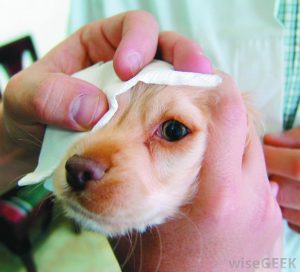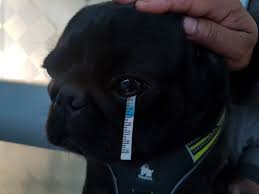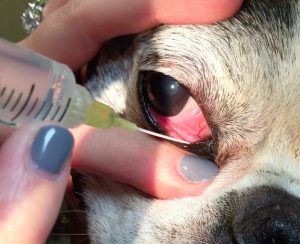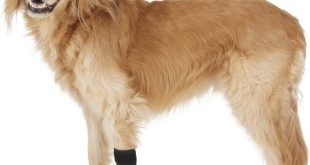Is your dog possibly suffering from epiphora? If you have by chance noticed an unusual spillage of tears from your dog’s eyes, your dog could be suffering from a condition called epiphora!
This condition is associated with a variety of ocular problems like; irritation, pain, or blockages in your dog’s tear drainage system as a result of an infection or foreign matter entering into its eyes.
Normally, a thin film of tears called the precorneal tear film is produced to lubricate your dog’s eyes and drain excess tears into the lacrimal duct located at the corner of your dog’s eyes. Then, the nasolacrimal duct carries the excess tears from the lacrimal sac of the eye into the nasal cavity.
But when your dog suffers from conditions like; scarring on the eyes due to conjunctivitis, and blockages in the tear drainage system, this can lead to epiphora which is caused by inadequate drainage of the tear film of your dog’s eyes.
Symptoms of Epiphora

You will observe;
- Watery discharge from the eyes.
- Redness of eyes, and irritation.
- Reddish-brown tear stains on the fur around the eyes.
- Pawing and scratching of the eyes due to incessant itching.
- possible change in the size of the pupil, or eyeball.
- Loss of sight – observe your dog for signs like; squinting or cloudiness. If your dog has long hair falling to cover its eyes, it’s advisable to keep this hair cut short so you can see its eyes better.
- Sagging skin around the eye – this exposes the delicate conjunctival tissues that line the inner surface of the eyelids, and cover the eyeball.
- Inflammation – a result of environmental irritants such as dust particles. This could also be due to autoimmune diseases, and allergic reactions.
- Swelling around eyes, or a constant discharge that looks like mucus.
If your dog exhibits these symptoms, you may want to see a veterinarian for diagnosis, and understanding of what might be the cause of such manifestations.
Is Epiphora a Disease?

Surprisingly, this excessive tearing in dogs is rarely a stand-alone health condition.
It is mainly a symptom rather than an illness itself.
The precorneal tear film has several important functions which are essential to your dog’s eye health, such as;
- Maintaining a moist environment on the eye surface to prevent your dog’s eyes against infections.
- Lubricating the surface of the eyes to facilitate the movement of your dog’s eyelids.
The aforementioned terms might seem a bit strange to you…especially if you’re just coming across them for the first time.
Below are some brief explanations for your better understanding.
What is a Precorneal Tear Film?

The precorneal tear film is an eye fluid, this fluid isn’t secreted as a complete solution.
It consists of numerous components which are secreted from various multiple glands distributed around the eye.
The precorneal film consists of three layers;
- Lipid layer: this layer helps to prevent the evaporation of tears from your dog’s eyes, to maintain the surface tension.
- Aqueous layer: this layer mainly contains water and nutrients, and it keeps your dog’s eyes moist.
- Mucus layer: the mucus helps the tears in your dog’s eyes spread evenly to promote the lubrication of the eyes, which keeps the eyes wet.
Note; there is no clear cut barrier between these three layers.
Where is the Precorneal Tear Film Located?
The precorneal tear film is located directly on the eye surface, and it’s always in direct contact with the conjunctiva and cornea of your dog’s eyes.
What is the function of the Precorneal Tear Film?
Because it is just directly on the surface of your dog’s eyes, it serves as the second line of ocular surface defence with the eyelids being the first.
Now, let’s move on to…
The Lacrimal Duct
This duct collects excess tears from the surface of your dog’s eyes.
Tears enter the duct system at the lacrimal puncta – a small opening on the edges of the eyelid near the nose – and move through canaliculi which are small channels in the eyelids that drain fluid from the lacrimal puncta to the lacrimal sac within the eyelids.
The lacrimal sac is an oval-shaped sac with its upper end closed and rounded; while its lower-end continues into the nasolacrimal duct.
This is the upper dilated end of the lacrimal duct. The lacrimal sac consists of a fibrous elastic coat lined internally by mucous membrane.
The mucus membrane is continuous, through the lacrimal ducts, with the conjunctiva, and through the nasolacrimal duct with the mucus membrane of the nasal cavity.
Next is…
The Nasolacrimal Duct

This is a duct that carries tears from the lacrimal sac of your dog’s eyes into its nasal cavity.
The starting point of the duct is between two bones in the eye socket called the maxillary and lacrimal bones.
From here, it continues backwards and downwards transporting excess tears to the nasal cavity, where it meets an opening covered by a mucosal fold – this is the nasolacrimal duct leading into the nasal cavity.
It is where excess tears drain into your dog’s nasal cavity, down to the back of its nose and throat.
Finally…
The Nasal Cavity
The nasal cavity is where excess tears drain into, here, you will find the nasal meatus, this nasal meatus refers to any of the three passages through your dog’s nasal cavity – located behind its nose.
These three passages are;
- The dorsal meatus; a passage between the roof of your dog’s nasal cavity and dorsal nasal concha.
- The middle meatus; between your dog’s dorsal and ventral conchae, it connects with its paranasal sinuses.
- The ventral meatus; the main pathway for airflow leading to your dog’s pharynx. It is positioned between the ventral nasal concha and the floor of its nasal cavity.
They are all located underneath each other in a corresponding nasal turbinate.
In summary, excess tears on the surface of your dog’s eyes go through the lacrimal duct, then is collected by the lacrimal sac, before going through the nasolacrimal duct, and finally getting to the nasal cavity where it enters to the back of your dog’s throat.
This is When there might be a Problem!
When the excess tears from your dog’s eyes do not follow this sequence and instead, rolls out of its eyes, there are high chances your dog might be suffering from a condition that’s causing this Epiphora.
However, epiphora is a common concern for pet owners because this condition is evident as an abnormal tear flow from the dog’s eyes which causes ugly tear staining on the dog’s face.
Types of Epiphora
-
Active Epiphora (related to the increase in tear production by the lacrimal glands) –
this often occurs when there’s pain or inflammation in your dog’s eye(s) which causes tears to accumulate in response to this pain or inflammation.
-
Passive Epiphora (related to the lack of tear drainage by the tear drainage system) –
this normally leads tears produced in the eyes to the nose and occurs when the lumen of the eye canal has obstructed a result of inflammatory stenosis, an infection, a foreign body, a conformational anomaly linked to your dog’s breed.
Eg. flat-nosed dogs and brachycephalic breeds. In this case, the tears accumulate at the base of the eye, then overflow from the eye.
What are the Causes of Epiphora?
No dog owner will be happy to see his/her loving pooch in discomfort.
This is why watching your dog is continuously pawing/scratching its eyes due to the itching will make you worried.
For this reason, well dive deeper into the main causes of epiphora.
-
An irritant in your dog’s eyes:
The eyes’ normal response to irritants is to produce excess tears to flush them out.
An overproduction in tears might overwhelm the tear drainage system. When tiny particles of dust, sand, grass, or tiny insects.
So when foreign things like these come in contact with your dog’s eyes, they should be removed immediately they are noticed. You can flush them out using clean water.
-
A food allergy reaction:
In some cases, food allergies can also cause watery eyes.
Your dog might be allergic to a certain type of food it consumed that could cause it to tear up. Just like we humans show different allergic reactions to certain foods.
Grains and dry food often irritate a dog’s digestive system and can lead to excessive tearing due to the ultra-processed nature of the food.
So endeavour to feed your dog a good quality diet.
-
A deformity in eyes which results in poor eyelid function:
In some cases, epiphora is caused when the upper/lower eyelids fold inwards and against the eyeballs and constantly touch the inner part of your dog’s eyes.
Also, The eyelashes can grow in the wrong direction to touch the surface of your dog’s eyes.
-
Blockage in the tear drainage system:
This happens when there is a blockage in the nasolacrimal duct of your dog’s eyes.
This usually happens when the punctae are blocked due to swelling (presence of an infection), or abnormally small holes/absence of holes all together.
The tears gather around and under the eyes area when there is nowhere to go which can lead to further eye infections, and rust coloured tear stains.
The blockage can also be as a result of the presence of foreign objects on the surface of the eyes.
If blockages are not treated, they could eventually generate more serious problems, such as orbital cellulitis (an infection of the fat and muscles around the eye).
-
Excessive production of tears:
usually, this is very rare. It happens when your dog’s lacrimal glands work overtime to produce excess tears even without an irritant in the eyes, blockage in its tear drainage system, or any underlying disease.
Other causes include;
-
An inflammation within or near the tear duct system
– leading to an excessive tear formation in your dog’s eye(s).
-
Scarring of tear duct after severe conjunctivitis
An infection of the outer membrane of the eyeball, and inner lid, It is also called pink eye, and It causes swelling of the conjunctiva due to allergies, or a viral/bacterial infection. It is very contagious and is spread by contact with eye secretions from an infected dog. This condition causes damage to the tear duct leading to excessive tearing).
-
An inflammation of your dog’s eyelids
– This condition is known as blepharitis. When this happens, the eyelids become red and itchy and dandruff-like scales begin to form on the eyelashes.
It is a common eye disorder caused by bacteria and it happens as a result of an accumulation of too much bacteria on your dog’s eyelids and base of its eyelashes.
-
Corneal ulcerations
Corneal ulcer happens when an open sore forms on the cornea of your dog’s eye.
It is usually caused by eye injury, inflammatory disorders, or vitamin A deficiency.
-
An Inflammation of the iris and ciliary body
This condition is termed “anterior uveitis”.
This is a painful, inflammatory disorder that is one of the most frequently observed eye diseases in dogs.
It is caused by various infections; including viral (rabies), bacterial (Lyme disease), parasitic (toxoplasmosis), or fungal (blastomycosis, histoplasmosis) metabolic disease (such as diabetes).
-
Glaucoma
This is the damage of the nerve connecting the eyes of your dog to its brain, usually due to high eye pressure.
This condition can eventually lead to blindness in your dog if left undiagnosed and untreated.
-
Teething
Teething puppies tend to produce more tears, and tear stains may become visible on the fur under their eyes.
-
The presence of smoke, chemicals, or soap on the surface of the eye
This is a common irritant that can make your dog’s eyes watery.
-
An infection around the eye, or within the eye socket
this causes your dog pain and discomfort which causes excessive tear formation.
Most of the disorders mentioned above can cause both blockages of tear flow (passive epiphora) and excessive tearing (active epiphora) to your pooch.
Is Epiphora Common for all Dog Breeds?
Epiphora is a condition that can affect all dog breeds. However, there are certain dog breeds in which this condition is more prevalent due to some factors like face physique or genetics (especially in dog breeds prone to eye defects).
Short-faced breeds like Shih Tzu, Pekingese, boxer, pug, Boston terrier and bulldog are vulnerable to epiphora due to their shallow eye sockets, and hair growth in the skin folds around the eyes, which hinders the tear drainage…
So, if you’re an owner of any of the aforementioned dog breeds, check for symptoms and read further to find out how you can manage this condition in your dog, or prevent it.
Poodles and Cocker spaniels are more prone to blocked tear ducts compared to any other breeds and inherited traits and disorders may be the reason.
Tear stains are more pronounced on light coloured dogs because it is most visible on their fur…These tear stains are caused by a pigment-containing molecule found in the tears.
These molecules are called porphyrins, and they contain iron which is responsible for the reddish/brown colouration as it gets darker when exposed to sunlight.
Treatment for Epiphora
This condition can be medically treated or treated through natural methods from home.
However, if you’re considering treating your doggy from home, it is advisable to check with your veterinarian first to ensure that you’re doing the right thing.
Medical Treatments for Epiphora
Treatment will vary depending on the underlying cause. Before treatment, you need to carry out a proper diagnosis to be sure about what you’re dealing with. The diagnosis should preferably be carried out by a veterinarian.
Diagnostic Tests
The diagnostic tests may include;
- Thorough and complete ocular examination by a vet.
- Evaluation of the nasolacrimal system for reduced drainage.
- Schirmer tear test to determine if tear production is normal, or excessive. (Schirmer tear test is a diagnostic test used to measure the rate of tear production, and evaluation of conjunctivitis to diagnose tear deficiency. Also used to check for the presence of patency of lacrimal puncta, and examine for the presence of a foreign body).
- Measurement of eye pressure (tonometry) to evaluate glaucoma. (Tonometry is a method of measuring intraocular pressure(IOP) during the complete ophthalmologic evaluation for dogs. It is also important for the diagnosis and control of glaucoma, and uveitis. The use of the rebound tonometer is increasing in veterinary medicine. The rebound tonometer is a portable tonometer with a small probe).
- Using saline to flush the tear duct system to determine if there is no blockage to the nasal cavity. Saline should be used to flush from the upper punctum to the lower punctum initially to assess the patency between the two puncta. This saline solution removes loosened debris when used as a rinse.
Once the condition has been diagnosed, treatment is the next step. With the advice of a professional, choose an appropriate treatment to suit the condition of your dog’s eyes.
Treatment Options
- In cases of blockage in your dog’s tear drainage system, a series of saline flushing, or corrective surgeries may have to be done. (Note that some forms of tear duct blockage are not correctable and could lead to chronic epiphora).
- Eye antibiotics or anti-inflammatory medications may be used to reduce irritation. Antibiotics are only used in case of an infection, while anti-inflammatory medications can be used in cases of swelling as a result of an injury.
- If your dog has eyelid, eyelashes, or facial hair deformities, corrective surgery may be required to stop irritations and eliminate epiphora.
- In cases of inflammation due to a fungus, bacteria, or parasite, a prescribed medication will be recommended by your vet. These may include eye drops or a topical ointment to help cure the Infection and reduce your dog’s pain and discomfort.
- If the cause of the epiphora is an object/particle in your dog’s eyes, it must be removed immediately, and the eye treated with anti-inflammatory medications. Do not use any product without consulting your veterinarian.
Natural Treatments for Epiphora
In case you suddenly notice epiphora in your pooch and your vet isn’t a call away, there are some home remedies you can try.
These may help ease your dog’s discomfort before you can access a veterinarian.
Here are some home remedies you can try
- Application of eye drops two to three times a day (as prescribed by your vet).
- Add some apple cider vinegar to your dog’s diet. This may help reduce this problem as it is known to have the ability to change the pH of your dog’s body. This pH change is said to help control the activity of its tear duct to an extent.
- Apply some boric acid as an ocular disinfectant. This is done by dissolving boric acid in warm water and applying this mixture in your dog’s eye(s).
Be careful while doing this and make sure the mixture is sterile to avoid further infecting your dog’s eyes.
Please check with your vet beforehand, maybe through a phone call, to know if this is safe for your dog’s breed.
- Check your dog’s eyes regularly and carefully remove any foreign object if you can.
- Give your dog water with lower minerals. This means you should avoid giving your dog tap water
Purified water is low in minerals and said to improve drainage in the case of watery eyes in dogs
- Cut the long hairs/fur on your dog’s face short to prevent them from touching its eyes directly. This could be a preventive measure, but if you notice your dog has epiphora as a result of its hair/fur touching its eyes, this is a great step to remedy the situation.
- You should also consider changing your dog’s bowl from stainless steel to plastic. Because using a shiny bowl could become an irritant for your dog’s eyes leading to epiphora. If you notice your dog has developed watery eyes, switching to a plastic feeding/water bowl could help.
Can Epiphora Cause Blindness in Dogs? Recommendations and Conclusion
Epiphora should be taken very seriously because delaying treatment could lead to blindness.
For you to realize early whether your dog has this condition, you need to pay close attention, observe your pooch’s eyes and behaviour.
The moment you notice any abnormality, especially if you haven’t recently taken your dog out in a dusty or smoky environment, visit you immediately.
Generally, you can’t be aware whether your dog has epiphora until the symptoms become visible. So preventing epiphora in dogs isn’t something you can do perfectly…
Although you can try by choosing the right diet to prevent food allergies, proper hygiene and grooming to prevent eye infections, avoiding strong chemicals, dust and smoke, and timely treatment when your dog contracts an eye infection.
Also, some supplements on the market are said to help your pooch reduce watery eyes and tear staining…you may want to try them – but remember to check with your vet before administering any supplement.
Note: some people recommend using hydrogen peroxide to clean tear stains, be careful as this substance might do more harm than good to your dog.
Cheers to seeking proper eye health for your loving buddy!
 Total Pooch Dog Supplements, Tear Stain Removers, De-wormers, Tylosin for Dogs and other great products.
Total Pooch Dog Supplements, Tear Stain Removers, De-wormers, Tylosin for Dogs and other great products.



